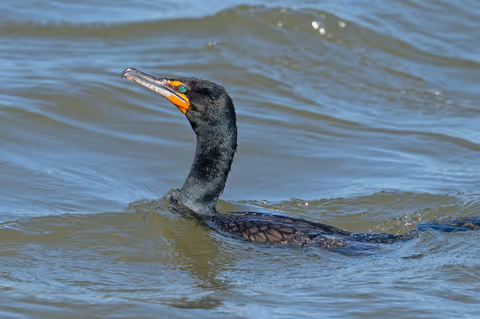Double-Crested Cormorants


Double-crested cormorants (Nannopterum auritus, formerly of the genus Phalacrocorax) are the most widely distributed cormorants in North America. They can be found as far north as the Aleutian Islands in Alaska and as far south as Sinaloa, Mexico and Cuba. There are five subspecies of double-crested cormorant, only one of which (Nannopterum auritus albociliatus) can be found year-round on the Pacific Coast.
Double-crested cormorants are long-necked water birds about 28 to 35 inches in length (70-90 cm) with a 45-48 inch wingspan (114-123 cm). They have turquoise eyes and the inside of their mouths are bright blue. Adults are black-brown with dark webbed feet, a dark hooked bill, and a patch of yellow-orange skin on their faces. They get their name from a double crest of feathers adults have during the breeding season. These crests are white among N. a. cincinnatum, found in southern Alaska and the Aleutian Islands, and grow darker further south in the range. Juveniles are overall lighter in color with a whitish throat and breast and a yellow-orange bill.
Double-crested cormorants are very adaptable birds. Their diet consists almost entirely of fish, though they will eat amphibians, insects, and crustaceans on occasion. They are able to dive 5 to 24.7 feet (1.5-7.5 m) beneath the surface in order to catch fish. As they are colonial birds, they can be found in a variety of aquatic habitats large enough to support their diet, including lakes, rivers, coastal islands, bays, and estuaries.
Their wings do not have as much preen oil compared to other species of water bird, which means their feathers are not waterproof. This decreases buoyancy, which allows them to move through the water more effectively, but as a result, they have to spend long periods of time with their wings outstretched in order to dry them after fishing.
Nests can occur on the ground, on rocks, on cliff edges, or in trees. Their guano is acidic and will typically kill any trees they nest in as well as damage any human-made structures they decide to nest on. If this happens, they may find a new nesting site or simply move their nests to the ground. Both males and females build the nests.
Clutches consist of 1-7 eggs (3-4 on average) which are incubated for 25-28 days. The cormorants begin to fledge at about 5 weeks old and become independent around 9 weeks old. In ground-nesting colonies, the young cormorants will leave the nest to gather amongst themselves in crèches, only returning to be fed.
Double-crested cormorants are considered to be of least concern on the IUCN Red List, but that was not always the case. They were negatively impacted by pesticide contamination of waterways during the mid 20th century. Pollutant regulations in the 1970s have resulted in cormorant populations growing steadily.
References
BirdLife International (2018). Nannopterum auritus. The IUCN Red List of Threatened Species 2018: e.T22696776A133552919. Retrieved August 1, 2022, from https://www.iucnredlist.org/species/22696776/133552919
Cornell Lab of Ornithology. (n.d.). Double-crested Cormorant . AllAbout Birds. Retrieved August 1, 2022, from https://www.allaboutbirds.org/guide/Double-crested_Cormorant/overview
Kaufman, K. (n.d.). Double-crested Cormorant. Audubon. Retrieved August 1, 2022, from https://www.audubon.org/field-guide/bird/double-crested-cormorant
National Parks Service. (2021). Double-crested Cormorant . National Parks Service. Retrieved August 2, 2022, from https://www.nps.gov/places/000/double-crested-cormorant.htm
© Laura Caldwell, August 2022
Touch whale bones, examine shipwreck artifacts and connect with the coast's living history.

Support our mission, get involved in educational programs, or contribute through donations and volunteering.